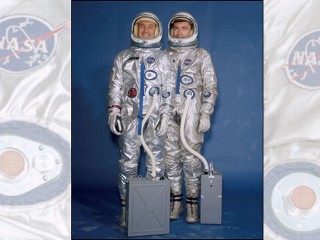The defining image of space exploration is set for a facelift as the spacesuit prepares for its first update since the late 1970s.
NASA has selected a company to design and outfit new spacesuits made specifically for lunar exploration. The Constellation Space Suit System contract, announced last week, is a critical step in sending a manned mission to the moon for the first time since Apollo 17 in 1972.
"We've now got all of our prime contracts in place," said Jeff Hanley, manager for the Constellation program at Houston's Johnson Space Center. He said he expects to have American astronauts "on [the] moon by end of the next decade."
The contract, awarded to Oceaneering International Inc of Houston, could be worth up to $745 million over the next 10 years. "We're ready to put them to work and get ready to put bootprints back on the moon," said Glenn Lutz, NASA project manager for Extravehicular Activity Systems.
Current suits, called extravehicular mobility units, like the ones used on the International Space Station and on shuttle missions, were "built for a completely different set of problems," and not for exploring the moon, Lutz said.
Early Spacesuits
Manned space flight began in 1961, and suit designers had to devise a way to maintain a stable internal pressure in the vacuum of space.
The first astronauts wore a suit called the Mark V suit -- a modified version of a pressure suit used by U.S. military pilots during high altitude flights. However, they did not inflate it, wearing it just in case the Project Mercury capsule lost pressure.
The Mercury missions ended in 1963, but the next generation of spacesuits was already being designed for Project Gemini. These new suits, despite being outfitted with temperature regulating systems, were the first designed to retain some flexibility when inflated.
On June 3, 1965, when Ed White became the first person to leave the relative safety of the spacecraft for the first spacewalk, he was wearing a Gemini spacesuit.
The Gemini suit was designed to work in zero gravity, but astronauts would need a much more sophisticated outfit if they were to achieve President Kennedy's goal of landing on the moon by the end of the decade.
Constellation Spacesuit
The EMUs NASA uses today are essentially a one-person spacecraft that protects astronauts from the hostile environment of deep space.
These suits "do great," Lutz said, "but they are built for floating in space" and not for exploring the lunar surface.
The Constellation missions will require astronauts to conduct experiments on the moon's surface, and the lunar explorers will need to be able to walk long distances over rocky terrain, climb ladders and bend to collect rock and dust samples -- all activities that would be difficult, if not impossible, using the Apollo spacesuit.
The new suits are being designed with a focus on increased dexterity, and to allow natural movement.
"We'll be able to put astronauts out on the lunar surface and turn them into explorers, geologists and educators," Lutz said. "Our design goal would be to make astronauts, when they're doing geology, look like a geologist on the surface of the Earth."
Lutz doesn't expect Oceaneering International Inc. and NASA to completely reinvent the iconic image of the NASA spacesuit.
"The jury's still out on what it will end up looking like," he said, adding, "It won't look drastically different from what people are used to seeing astronauts wear."





No comments:
Post a Comment